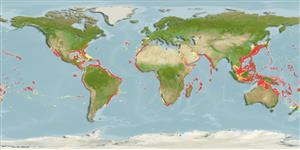Common names from other countries
>
Scombriformes (Mackerels) >
Bramidae (Pomfrets)
Etymology: Taractes: Greek, taraktes = confusion; for the pletora of names that have been applied to this fish (Ref. 45335).
More on authors: Jordan & Evermann.
Environment: milieu / climate zone / depth range / distribution range
Écologie
marin benthopélagique; océanodrome (Ref. 51243); profondeur 0 - 600 m (Ref. 82736). Tropical
Pacific and Atlantic: widely distributed in tropical waters (Ref. 559). Eastern Central Pacific: Costa Rica to Peru. Eastern Atlantic: off west Africa. Western Atlantic: Gulf of Mexico, Trinidad. Not known from the Indian Ocean (Ref. 4936). Recently reported in Aden Gulf, Arabian Sea (Ref. 85285). Highly migratory species.
Taille / Poids / Âge
Maturity: Lm ? range ? - ? cm
Max length : 89.0 cm TL mâle / non sexé; (Ref. 97146); common length : 30.0 cm TL mâle / non sexé; (Ref. 55763)
Épines dorsales (Total) : 0; Rayons mous dorsaux (Total) : 30 - 32; Épines anales: 0; Rayons mous anaux: 21 - 23. Caudal peduncle with a strong keel formed of enlarged and fused scales. Scaleless areas above and behind the eyes. Lateral line in adults obsolete. Fins of juveniles very long. Attains 70 cm SL.
Adults occur from shallow water to about 600 m depth offshore (Ref. 82736). Often solitary (Ref. 82736).
Life cycle and mating behavior
Maturities | Reproduction | Spawnings | Egg(s) | Fecundities | Larves
Gomes, J., 1990. Bramidae. p. 758-764. In J.C. Quero, J.C. Hureau, C. Karrer, A. Post and L. Saldanha (eds.) Check-list of the fishes of the eastern tropical Atlantic (CLOFETA). JNCT, Lisbon; SEI, Paris; and UNESCO, Paris. Vol. 2. (Ref. 4936)
Statut dans la liste rouge de l'IUCN (Ref. 130435)
CITES (Ref. 128078)
Not Evaluated
Menace pour l'homme
Harmless
Utilisations par l'homme
Pêcheries: commercial
Outils
Articles particuliers
Télécharger en XML
Sources Internet
Estimates based on models
Preferred temperature (Ref.
115969): 12.7 - 26.1, mean 18.6 (based on 1171 cells).
Phylogenetic diversity index (Ref.
82804): PD
50 = 0.7500 [Uniqueness, from 0.5 = low to 2.0 = high].
Bayesian length-weight: a=0.01122 (0.00514 - 0.02450), b=3.04 (2.87 - 3.21), in cm Total Length, based on all LWR estimates for this body shape (Ref.
93245).
Niveau trophique (Ref.
69278): 4.3 ±0.6 se; based on size and trophs of closest relatives
Résilience (Ref.
120179): Haut, temps minimum de doublement de population inférieur à 15 mois (Fec > 10,000).
Fishing Vulnerability (Ref.
59153): High vulnerability (56 of 100).
